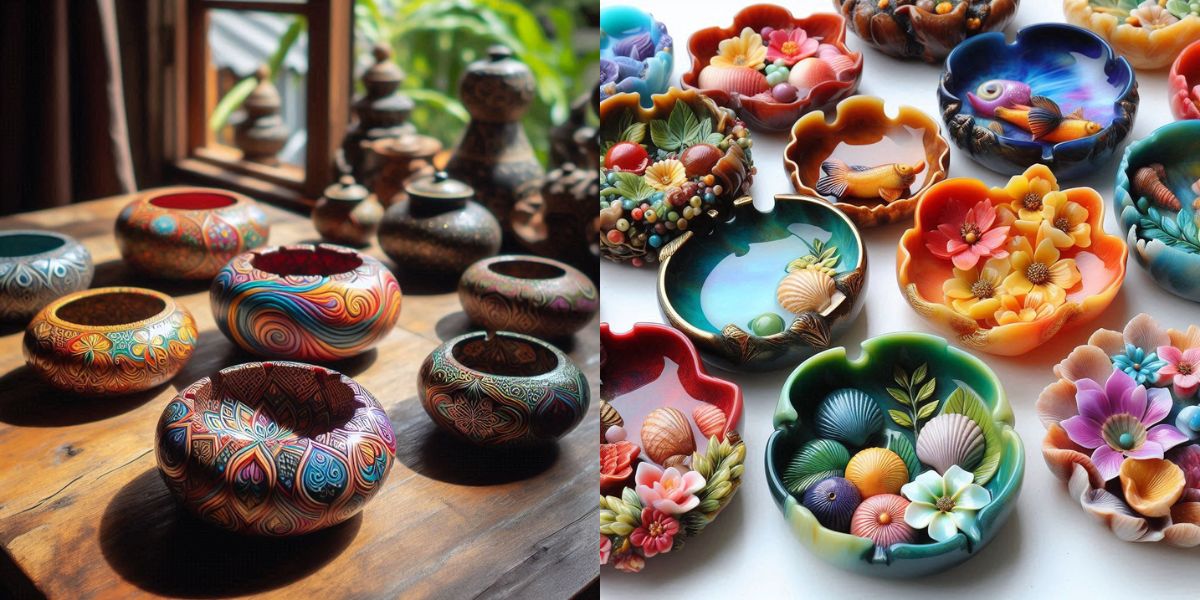Ashtrays have come a long way from being simple functional objects to becoming artistic expressions that blend form and function. The evolution of ashtray design reflects changing cultural trends, advancements in craftsmanship, and a growing appreciation for everyday objects as works of art. Today, ashtrays serve as both practical accessories and decorative pieces, showcasing the ingenuity of their creators and the artistic vision behind their design.
The Humble Beginnings: Early Ashtrays

Ashtrays originated out of necessity. As smoking gained popularity in the 19th and 20th centuries, people needed a way to contain the ash and cigarette butts that came with it. Early ashtrays were typically made of basic materials like tin, ceramic, or wood. Their designs were utilitarian, focused solely on providing a safe space for smokers to discard ash.
At this stage, there was little attention given to aesthetics. However, as smoking became more socially acceptable and even fashionable, ashtrays started becoming part of the décor in homes, restaurants, and public spaces. This shift marked the beginning of the art of ashtray design, where functionality was paired with visual appeal.
Mid-Century Modernism and the Ashtray Renaissance
The mid-20th century marked a golden age for ashtray design, particularly during the rise of the mid-century modernist movement. Designers like George Nelson and Raymond Loewy, known for their sleek, innovative creations, began experimenting with materials and shapes in ashtray design. This era saw ashtrays crafted from materials such as stainless steel, glass, and ceramics, often with bold, abstract shapes that aligned with the minimalist aesthetic of the time.
Ashtrays of this period became iconic, transcending their role as smoking accessories and transforming into statement pieces for modern homes. The art of ashtrays in this era was marked by creativity and experimentation, with designers pushing the boundaries of what an ashtray could be. These designs were often sleek, geometric, and colorful, making them collectible items even in contemporary times.
Ashtrays as Art Objects
As smoking declined in many parts of the world, the functional need for ashtrays has diminished. However, their status as artistic objects has continued to rise. Many people now view ashtrays as art objects, often seeking out vintage or handcrafted pieces for their aesthetic value rather than their utility.
Today, artists and designers continue to craft ashtrays that blur the line between function and art. Contemporary ashtray designs often incorporate a wide range of materials such as ceramic, metal, wood, and even resin, with intricate details that reflect the creator’s artistic vision. Some ashtrays are adorned with hand-painted patterns, carvings, or metallic accents, making them unique and highly desirable as decorative pieces.
Ashtrays are often displayed as part of a home’s décor, even in spaces where smoking is no longer common. They can be placed on coffee tables, shelves, or sideboards as standalone pieces of art, adding a touch of elegance and sophistication to the room. This shift has given ashtrays a new life, allowing them to remain relevant and appreciated even in non-smoking households.
Custom and Handcrafted Ashtrays
Another dimension of the art of ashtrays is the rise of custom and handcrafted pieces. In recent years, there has been an increasing demand for personalized ashtrays that reflect the individual tastes and personalities of their owners. Artisans and craftsmen now create bespoke ashtrays that incorporate unique designs, initials, or meaningful symbols for their clients.
Handcrafted ashtrays also allow for a greater level of creativity, as each piece can be made with unique materials, colors, and shapes. This makes every ashtray a one-of-a-kind work of art, adding to its value and appeal. For instance, a ceramic ashtray may feature hand-painted floral designs, while a wooden ashtray could be carved into intricate shapes that reflect cultural or personal motifs.
The Role of Sustainable Design
In recent years, sustainability has become a key factor in ashtray design. As environmental concerns have grown, designers have turned to eco-friendly materials and production methods to create ashtrays that minimize their environmental impact. This trend has led to the creation of ashtrays made from recycled materials, biodegradable components, and even organic substances like bamboo.
The use of sustainable materials adds a new layer to the art of ashtrays, showcasing the ability to balance aesthetics with environmental responsibility. These designs often emphasize natural beauty, with organic shapes and textures that appeal to eco-conscious consumers. By focusing on sustainability, modern ashtray designers are ensuring that their creations are not only visually appealing but also aligned with the values of today’s consumers.
Collecting Ashtrays: A Growing Trend
For enthusiasts and collectors, ashtrays have become valuable collectibles that reflect both historical and artistic significance. Vintage ashtrays, particularly those from the mid-20th century, are highly sought after by collectors due to their unique designs and historical context. Some ashtrays have even become iconic symbols of specific eras, such as the Art Deco movement, with their bold lines and geometric patterns.
Collectors often search for rare and limited-edition ashtrays, treating them as pieces of art that can be displayed and admired. This growing trend has increased the demand for ashtrays in the antique and vintage market, further solidifying their place as collectible art objects.
Conclusion
The art of ashtrays has undergone a fascinating transformation, evolving from simple, functional objects into highly artistic and collectible pieces. Whether as a symbol of mid-century modernism, a handcrafted statement piece, or a sustainable design, ashtrays continue to captivate designers and collectors alike. In modern times, their aesthetic appeal has outgrown their original purpose, proving that even the most utilitarian objects can become timeless works of art.
